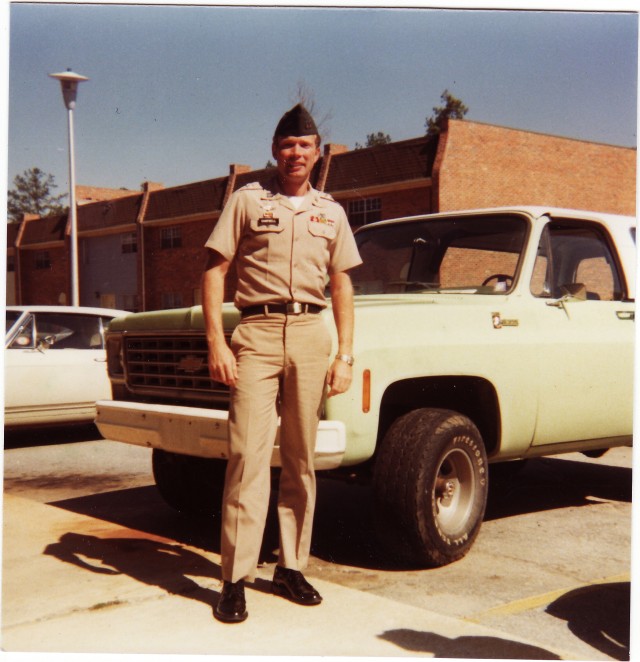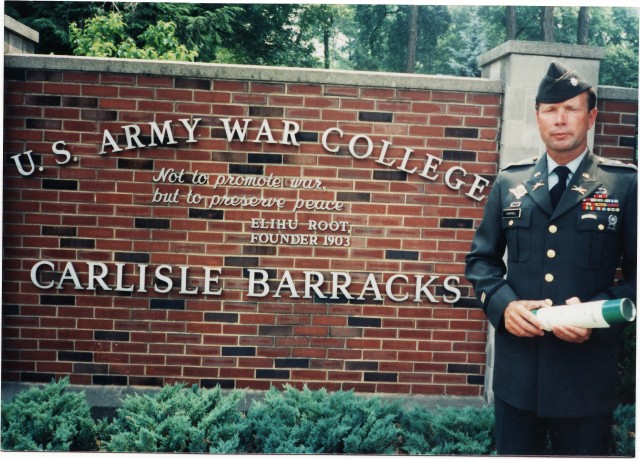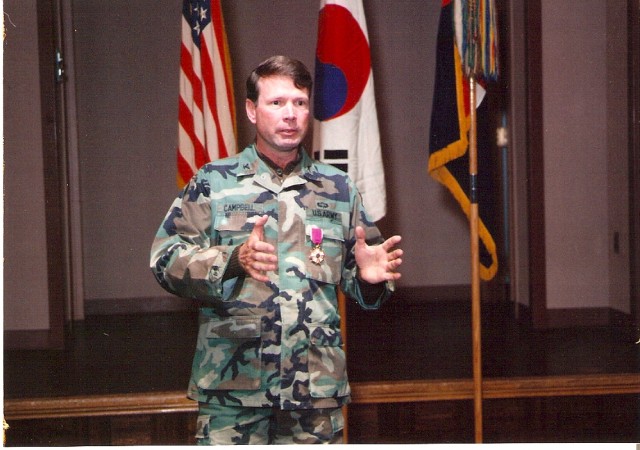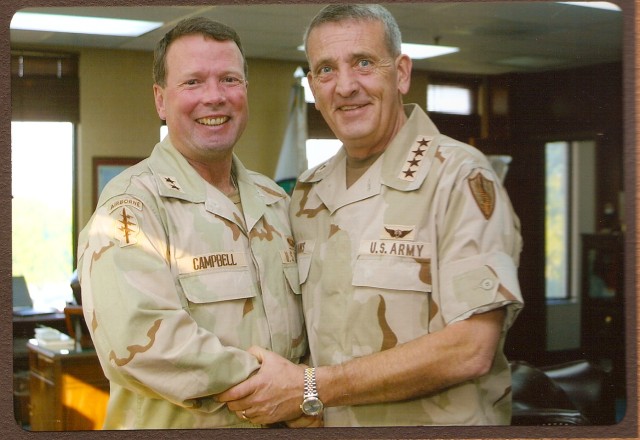FORT McPHERSON, Ga. (June 1, 2010) -- After 40 years of Army service dating back to the Vietnam War, Gen. Charles C. "Hondo" Campbell, commander of U.S. Army Forces Command, will retire here, during a combined retirement/change of command ceremony June 3.
Campbell took over the Army's largest command Jan. 9, 2007, becoming the 17th commander of FORSCOM. When he relinquishes command and steps into retirement, another chapter in the legacy of the Vietnam War comes to a close, because Campbell is the last continuously-serving general officer who saw action in Vietnam to leave active duty.
As for the origin of Campbell's now famous nickname, "Hondo," it is somewhat obscure. The "folklore" suggests it is related to the character in the Louis L'Amour western novel by the same name, a role played by John Wayne in the movie version of the classic tale. Whatever the origin, it's a name he has carried with pride during his decades-long career.
40 years of change
Campbell entered the Army in 1970 when the active component was 1.2 million Soldiers strong, and it was a conscripted force. "When I went to Vietnam, we had more than 500,000 Soldiers in Vietnam (alone)," said Campbell. Compared to the size of today's all-volunteer active component - about 560,000 - it was certainly a far different Army.
"So when I look across broad brush strokes of 40 years, there were three points that were really strategic, in my view, as it relates to the Army," said Campbell.
Aca,!Ac The first occurred in July 1973 when the Army became an all-volunteer force. It had to reinvent itself to embrace a doctrine of maneuver for a possible fight against the Soviet threat.
Aca,!Ac The second point happened in 1989 when the Berlin Wall collapsed, and the Army had to reinvent itself into an expeditionary force.
Aca,!Ac The third turning point came on Sept. 11, 2001, after which the Army had to become really campaign capable in order to prosecute a protracted conflict.
Post '9-11' Change
"The Army of today is a fundamentally different from the Army of 2001," Campbell said. "We have adapted for the present and the future fight. We have moved from a division structure to a brigade-centric modular structure, from a linear force generation model to a rotational force generation model that is characterized by progressive readiness and cyclical deployment, and from a National Guard and Army Reserve that was a strategic force to one that is fully integrated into the operational force and are (now) making proportional contributions every day," he said.
Campbell has commanded all Continental U.S.-based conventional operating forces for much of the last four years. "Our Army is clearly fatigued by nearly nine years of combat. But, through it all, our Army remains resilient, determined and extraordinarily effective. Our Soldiers today are more expert, better educated, better trained, more lethal and more combat-experienced than at any time, certainly in the 40 years I have served in the ranks," said Campbell.
Looking back on the time since he arrived at FORSCOM as its deputy commanding general in 2006 before later assuming command, Campbell noted how things have changed. "For many, many years, FORSCOM was a management headquarters. In the last four years, it was become an operating headquarters. That's a significant change that has been lost on many. (But,) It's not lost on anyone who has been assigned to Forces Command."
Another huge change during Campbell's tenure, to FORSCOM and to the Army, has been the birth and refinement of the rotational force generation model that is now known as Army Force Generation or ARFORGEN. "I'm not sure that I made that happen, but I will say a big deal of it happened during the four years I've been with Forces Command," said Campbell.
'Modularity' started paradigm shifts
It kind of grew out of what Campbell explained are three major paradigms shifts that have been occurring in the Army, particularly within the operating forces of the Army.
"The first was (former Army Chief of Staff) General Schoomaker's decision to modularize the force," said Campbell. "He made that decision in 2003. Since then, we've worked as an Army diligently to modularize the force. By the end of 2011, we'll have completed modularizing the force - that's 301 brigades."
The second shift relates to altering the Army's strategic concept of force generation.
In other words, that paradigm shift is ARFORGEN. This is the notion of generating forces that are progressively ready across the components, and then cyclically deployed during periods of availability based on combatant commanders' requirements and operational support taskings of the service. "That has been a huge change, and it has been wedded to a third paradigm change that relates to the (ongoing) efforts to operationalize the National Guard and the Army Reserve."
The ARFORGEN concept was "birthed" at Forces Command. "It was approved for implementation in the summer of 2006, actually (it was) shortly after I arrived at Forces Command as the Deputy Commanding General/Chief of Staff. Over the past four years, the (ARFORGEN) model has been matured, the process has been refined," said Campbell.
When it comes to the Guard and Reserve, Campbell said there have been massive strides taken to improve readiness in the Guard and Reserve. "It has emerged as a national treasure, it is more seasoned, more capably led, more robustly manned and better equipped than at any time since World War II," Campbell said. "Certainly, we need to continue our effort to operationalize the Guard and Reserve and to ensure it is fully integrated in the operating force, and that it continues to make a proportional contribution in the years ahead as it has done in the recent past."
At the Beginning
Campbell, a native of Shreveport, La., earned his commission through the Reserve Officer Training Corps at Louisiana State University. His initial assignment was as an instructor at the Infantry Training Command (Provisional), U.S. Army Training Center Infantry, Fort Ord, Calif.
After Special Forces training, Campbell taught tactics at Forces Armee' National Khmere Training Command, Army Advisory Group, Phouc Tuy Training Battalion, U.S. Army, Vietnam. While in Vietnam, he subsequently served as A-Detachment executive officer and commander.
Campbell's succeeding commands include a combat support company in the 2nd Armored Division, Fort Hood, Texas; an armor battalion in the 3rd Armored Division, U.S. Army Europe; and a heavy brigade in the 2nd Infantry Division, Eighth Army, Republic of Korea; Commanding General, 7th Infantry Division, Fort Carson, Colo.; and Commanding General, Eighth Army in Korea.
He also served in many staff assignments during his career, including six times as Chief of Staff for units with areas of responsibility ranging from Germany, to Korea, the Middle East, Central Asia, the Persian Gulf, the Horn of Africa and within the continental United States.
Campbell holds a Bachelor of Arts degree in history from Louisiana State University, and a Master of Military Art and Science degree from the U.S. Army Command and General Staff College. He has also attended a wide variety of military schools, culminating with his graduation from the Army War College in 1991.
Campbell's military awards and decorations include the Distinguished Service Medal, Defense Superior Service Medal, Legion of Merit (third oak leaf cluster), Bronze Star Medal, Meritorious Service Medal (fifth oak leaf cluster), Army Commendation Medal (with oak leaf cluster), Army Achievement Medal, Special Forces tab, and the Parachutist Badge.
Upon his retirement, Gen. Campbell and his wife Diane will settle in his hometown, Shreveport, La.
















Social Sharing